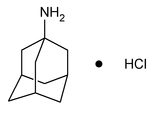Amantadine Hydrochloride
C10H17N·HCl 187.71
Tricyclo[3.3.1.13,7]decan-1-amine, hydrochloride;
1-Adamantanamine hydrochloride

 [665-66-7].
[665-66-7].
(a man' ta deen hye'' droe klor' ide).
C10H17N·HCl 187.71
Tricyclo[3.3.1.13,7]decan-1-amine, hydrochloride;
1-Adamantanamine hydrochloride
DEFINITION
Amantadine Hydrochloride contains NLT 98.5% and NMT 101.5% of C10H17N·HCl.
IDENTIFICATION
• A. Infrared Absorption  197S
197S
Cell:
1 mm
Sample solution:
50 mg in 10 mL of 0.1 N hydrochloric acid, and filter. Transfer the filtrate to a suitable separator, add 1 mL of 5 N sodium hydroxide, and extract with 5 mL of methylene chloride.
Acceptance criteria:
Meets the requirements
ASSAY
• Procedure
Sample:
Dissolve 120 mg of Amantadine Hydrochloride in a mixture of 30 mL of glacial acetic acid and 10 mL of mercuric acetate TS.
Analysis:
Titrate with 0.1 N perchloric acid VS, determining the endpoint potentiometrically, using suitable electrodes. Perform a blank determination. Each mL of 0.1 N perchloric acid is equivalent to 18.77 mg of amantadine hydrochloride (C10H17N·HCl).
Acceptance criteria:
98.5%–101.5%
IMPURITIES
• Heavy Metals, Method I  231
231
Test preparation:
Use 1 mL of 1 N acetic acid.
Acceptance criteria:
NMT 10 ppm
• Organic Impurities
Internal standard solution:
50 mg/mL of adamantane in dichloromethane
Standard solution:
Transfer 10 mg of USP Amantadine Hydrochloride RS to a separator. Add 20 mL of 5.0 N sodium hydroxide and 18 mL of dichloromethane, and shake for 10 min. Remove the water layer, dry the organic layer by swirling with anhydrous sodium sulfate, and allow to stand for a few min to ensure that all remaining water has been removed. Filter, collect the filtrate in a 20-mL volumetric flask, add 0.2 mL of Internal standard solution, and dilute with dichloromethane to volume.
Sample solution:
Transfer 1.0 g of Amantadine Hydrochloride to a separator. Add 20 mL of 5.0 N sodium hydroxide and 18 mL of dichloromethane, and shake for 10 min. Remove the water layer, dry the organic layer by swirling with anhydrous sodium sulfate, and allow to stand for a few min to ensure that all remaining water has been removed. Filter, collect the filtrate in a 20-mL volumetric flask, add 0.2 mL of Internal standard solution, and dilute with dichloromethane to volume.
Chromatographic system
Mode:
GC
Detector:
Flame ionization
Detector temperature:
300
Column:
0.53-mm × 30-m fused-silica column coated with 1.0-µm G27 stationary phase
Column temperature:
See Table 1.
Table 1
| Initial Temperature ( |
Temperature Ramp ( |
Final Temperature ( |
Hold Time at Final Temperature (min) |
|---|---|---|---|
| 70 | 0 | 70 | 5 |
| 70 | 10 | 250 | At least 17 |
Carrier gas:
Helium
Flow rate:
4 mL/min
Injection size:
2 µL
Injector temperature:
220
Injection type:
Split flow:
200 mL/min
Split flow ratio:
50:1
System suitability
Sample:
Standard solution
[Note—The relative retention times for adamantane and amantadine are about 0.7 and 1.0, respectively. ]
Suitability requirements
Resolution:
NLT 20 between adamantane and amantadine
Relative standard deviation:
NMT 5.0% determined from the peak response ratios of amantadine to adamantane
Analysis
Samples:
Standard solution and Sample solution
Calculate the percentage of each impurity in the portion of amantadine hydrochloride (C10H17N·HCl) taken:
Result = (RU/RS) × (CS/CU) × 100
| RU | = | = peak response ratio of each impurity to adamantane from the Sample solution |
| RS | = | = peak response ratio of amantadine to adamantane from the Standard solution |
| CS | = | = concentration of USP Amantadine Hydrochloride RS in the Standard solution (mg/mL) |
| CU | = | = concentration of the Sample solution (mg/mL) |
Acceptance criteria
Individual impurities:
NMT 0.3%
Total impurities:
NMT 1.0%
SPECIFIC TESTS
• Clarity and Color of Solution
Sample:
Dissolve 2 g in 10 mL of water.
Acceptance criteria:
Solution is clear and nearly colorless.
ADDITIONAL REQUIREMENTS
• Packaging and Storage:
Preserve in well-closed containers.
Auxiliary Information—
Please check for your question in the FAQs before contacting USP.
| Topic/Question | Contact | Expert Committee |
|---|---|---|
| Monograph | Behnam Davani, Ph.D., M.B.A.
Senior Scientific Liaison 1-301-816-8394 |
(SM12010) Monographs - Small Molecules 1 |
| Reference Standards | RS Technical Services 1-301-816-8129 rstech@usp.org |
USP35–NF30 Page 2153
Pharmacopeial Forum: Volume No. 31(5) Page 1344

